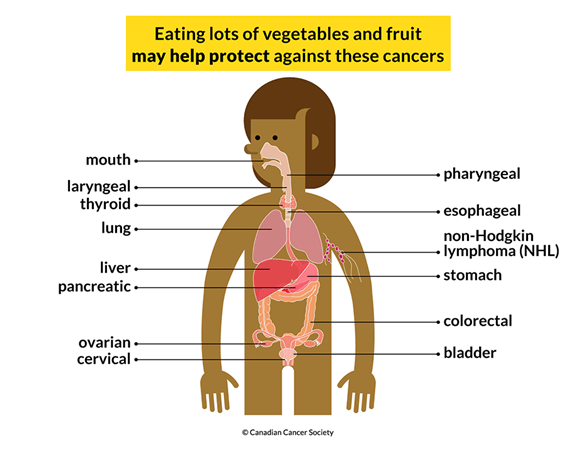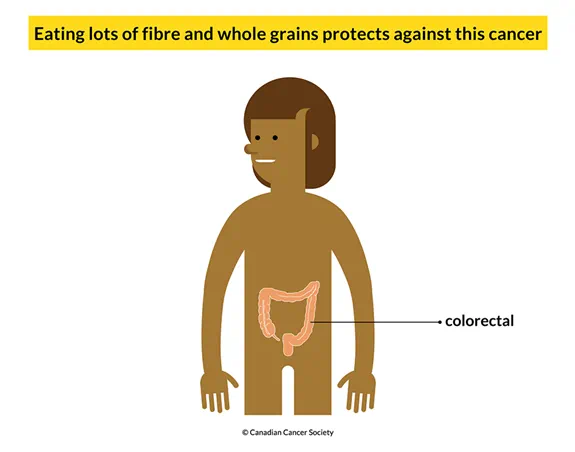Eat more veggies, fruit and fibre

Vegetables and fruit may help prevent cancer
Eating lots of vegetables and fruit may help protect against at least 14 different cancers.

We could all eat more vegetables and fruit
When it comes to eating well, you can’t do any better than vegetables and fruit! In fact, people of all ages should eat more vegetables and fruit every day.
The number of servings of vegetables and fruit you should have every day depends on your age, sex and activity level.
What's a serving?
- 250 mL (1 cup) of leafy raw vegetables or salad
- 1 piece of fruit, such as a medium apple, orange or banana
- 125 mL (1/2 cup) fresh, frozen or canned vegetable or fruit or 100% juice
Easy ways to eat enough vegetables and fruit every day
To get the right amount of vegetables and fruit you need each day, make them half your plate at every meal and snack. This might be as easy as adding 1 more serving of vegetables or fruit at each meal. Be creative and explore a variety of colours, tastes and textures!
Here are 4 ways to get more vegetables and fruit into your daily diet.
When fresh vegetables and fruit are not in season, choose frozen, canned or dried options. Most frozen and canned foods are processed within hours of harvest, so their flavour and nutrients are preserved. In the spring and summer, visit your local farmers market for fresh and tasty vegetables and fruit.
Put tomatoes and cucumber in sandwiches, berries in yogurt and cereal, or extra vegetables in pasta, rice, stir-fries and soups. Add a side salad to your lunchtime sandwich or pack vegetable sticks with a low-fat dip.
Nothing looks less appetizing than chicken breast, cauliflower and boiled potatoes on a white plate. Skip the boiled potatoes and add stir-fried red and green bell peppers along with roasted sweet potato wedges.
Juice doesn’t give you as much fibre, and it won’t make you feel as full.

Fibre: a main ingredient of eating well
Eating lots of fibre and whole grains protects against colorectal cancer. Want to have a healthy body weight and a healthy digestive system? Eat more fibre!

How much fibre do I need every day?
Also known as roughage, fibre helps with healthy digestion and makes you feel full longer so you don’t overeat. Health Canada recommends that adult Canadians get 25 to 38 grams of fibre each day for good health. Most of us only get half of that. Dietitians of Canada has plenty of examples of foods and their fibre content.

Which foods have fibre?
Fibre is found only in plant foods. The best sources of fibre include:
- whole grains
- vegetables
- fruit
- beans
- peas
- lentils
- nuts and seeds

6 ways to get more fibre
Here are 6 ways to get more fibre into your diet.
Vegetables and fruit are full of fibre. Make sure to eat both raw and cooked vegetables. Eat mashed, baked or roasted potatoes with the skin on (it’s where you’ll find the most fibre).
High-fibre foods have at least 4 grams of fibre per serving. When buying packaged foods, look for ones that show a 15% DV (daily value) or higher on the nutrition label.
Look at the ingredients list rather than the colour of the foods. Some brown bread is simply white bread coloured with molasses. The first ingredient should be a whole grain, such as whole grain wheat, oats, whole grain corn, barley or brown or wild rice.
Go for bran or whole grain breakfast cereals. Add bran to your favourite cereal or sprinkle on top of low-fat yogurt.
Swap whole wheat pasta for regular pasta and bake with whole wheat flour. You can substitute half of the white flour with whole wheat flour in most recipes with little difference in taste and texture. For example, if your recipe calls for 250 mL (1 cup) of flour, you can use 1/2 cup of white and 1/2 cup of whole wheat flour.
Pulses are the edible seeds of plants in the legume family. Add pulses such as beans or lentils to your soups, casseroles, stews and curries. Try chickpeas in salads, lentils in meatloaf or kidney beans in burritos.
